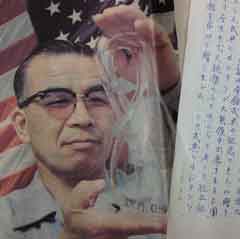December 8, 2015
Ohno family donates famed glassblower's journals to K-State Libraries
Submitted by Sarah McGreer Hoyt

If you've spent time in the K-State Union, you've probably seen Mitsugi Ohno's work: He created the astoundingly intricate glass sculptures of ships and famous U.S. buildings on display throughout the building.
Ohno's life was as fascinating as his art, and for more than 40 years he kept a journal, recording his experiences in precise Japanese script. All told, he filled more than two dozen thick, spiral-bound notebooks.
The Ohno family recently donated this extensive record of Mitsugi Ohno's life to K-State Libraries' Richard L.D. and Marjorie J. Morse Department of Special Collections.
Ohno was recruited from the University of Tokyo by K-State chemistry professor Alvin B. Cardwell in the late 1950s. The journals begin with Ohno's reflections on his 1961 arrival in the U.S. with his wife and two small children.
Even though he didn't speak English, Ohno quickly gained a reputation for being able to make anything the chemistry faculty required for their experiments. In fact, shortly after his arrival, Ohno produced a true Klein bottle, a task that glassblowers had long considered technically impossible.
Ohno's mastery was not limited to creating scientific glass.
In the second half of his life he became an accomplished artist as well, ultimately creating more than 24 intricate scale-model buildings and sailing ships that each took 500 to 2,000 hours to craft.
The first of Ohno's creations was the USS Constitution, which he completed in 1972 and gifted to the Eisenhower Presidential Museum. The largest was his 1976 U.S. Capitol building, which is held by the Smithsonian Institution in Washington, D.C. It was followed by Independence Hall, a gift to the White House.
On campus, you can find his replicas of the Nina, Pinta, Santa Maria and Mayflower, as well as Anderson Hall, Cardwell Hall, the USS Nimitz, the USS Missouri and the White House.
He retired in 1996 as senior master glassblower and died in 1999.
"I've read that Mitsugi's work eventually burned away his fingerprints, but no one can say he didn't leave his unique mark on the K-State campus," said Lori Goetsch, dean of K-State Libraries. "We're honored that the family thought to donate his journals to K-State Libraries."
To view the Ohno journals and a vast array of other unique materials, visit the Richard L. D. and Marjorie J. Morse Department of Special Collections on Hale Library's fifth floor.
The Morse Department of Special Collections is open 8 a.m. to 5 p.m. Monday through Friday. They offer a wide range of services for instructors, students and the general public in using or learning more about the books, manuscripts, photographs, other materials in the collection. For more information, visit www.lib.k-state.edu/special-collections.
